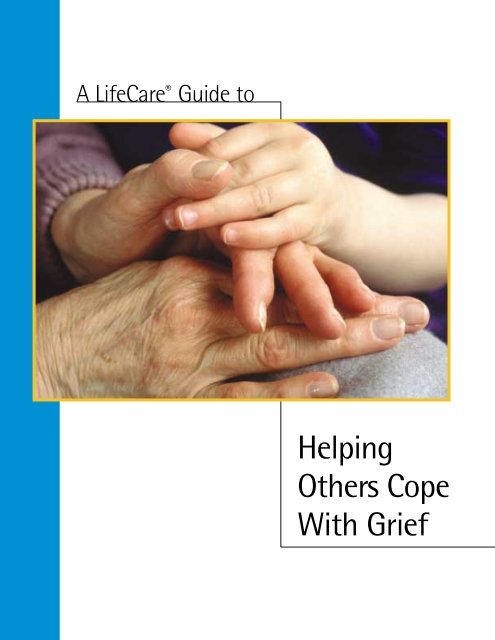Helping Others Cope With Grief - U.S. Department of Health and ...
Helping Others Cope With Grief - U.S. Department of Health and ...
Helping Others Cope With Grief - U.S. Department of Health and ...
You also want an ePaper? Increase the reach of your titles
YUMPU automatically turns print PDFs into web optimized ePapers that Google loves.
A LifeCare ® Guide to<strong>Helping</strong><strong>Others</strong> <strong>Cope</strong><strong>With</strong> <strong>Grief</strong>
Just as despair can come to one only from other human beings,hope, too, can be given to one only by other human beings.—Elie WeiselHonest listening is one <strong>of</strong> the best medicineswe can <strong>of</strong>fer the dying <strong>and</strong> the bereaved.—Jean CameronThis publication is for general informational purposes only <strong>and</strong> is not intendedto provide any user with specific authority, advice or recommendations.Copyright © 2001 LifeCare ® , Inc. All rights reserved.LifeCare ® , Inc. is a worldwide leader in Life Event Management SM Services.http://www.lifecare.comPrinted on recycled paper. CCover Photo by: © Jon Feingersh/The Stock Market
“The friend who can besilent with us in a moment<strong>of</strong> despair or confusion, whocan stay with us in an hour<strong>of</strong> grief <strong>and</strong> bereavement,who can tolerate not knowing,not curing, not healing<strong>and</strong> face with us the reality<strong>of</strong> our powerlessness, that isthe friend who cares...”—Henri Nouwen, fromOut <strong>of</strong> SolitudeIf someone you know has lost a loved one, you may need to provide help <strong>and</strong> supportas he or she grieves. It’s natural to want to <strong>of</strong>fer compassion <strong>and</strong> sympathy to someonewho has suffered a loss. However, you may not know how to help someone elsewho is in such obvious pain. While not everyone wants or needs the same kind <strong>of</strong>support, this guide provides you with suggestions on how to support a grievingfriend or family member.If you are also grieving a death while trying to support a loved one, you may need additionalhelp. Please refer to the companion piece to this guide, A LifeCare ® Guide to <strong>Grief</strong><strong>and</strong> Bereavement, for information on managing your own grief.Page 1
A LifeCare® Guide to <strong>Helping</strong> <strong>Others</strong> <strong>Cope</strong> <strong>With</strong> <strong>Grief</strong>Supporting Someone Who Is Grieving<strong>Grief</strong> is a natural process that affects people when they experience a loss—<strong>of</strong> arelative or friend; human or animal. Grieving people most <strong>of</strong>ten need others tosimply listen <strong>and</strong> care, not <strong>of</strong>fer a lot <strong>of</strong> advice. If you are trying to be supportive tosomeone who is grieving, remember that the emotions he or she is experiencing areuniversal, <strong>and</strong> the intensity <strong>and</strong> duration <strong>of</strong> these feelings will vary by individual—they cannot be rushed. You may not be able to ease another person’s pain, but youcan help him or her manage this difficult experience. The following suggestions mayhelp:Tips for <strong>Helping</strong> a Loved One Mention the person who has died, <strong>and</strong> acknowledge your awareness<strong>of</strong> the loss. Continue to do this as time goes on, not just right after thedeath. Many people avoid mentioning the person who has died, fearing itwill remind the grieving person <strong>of</strong> his or her pain. Often, people avoidthe topic because they feel uncomfortable or helpless, but behaving as ifyou don’t remember or are unaware <strong>of</strong> your loved one’s pain <strong>of</strong>ten leaveshim or her feeling very alone. Listen to your loved one. A grieving person may need to tell his or herstory again <strong>and</strong> again as part <strong>of</strong> the grieving process. The most importantthing you can <strong>of</strong>fer someone who is grieving is your ability to listen withoutjudgment. A good rule to follow is to listen 80 percent <strong>of</strong> the time<strong>and</strong> talk 20 percent. Remember, the way you can most help someone is bycommunicating a willingness to stay with him or her despite the pain. Insist that your loved one see a doctor if he or she exhibits signs <strong>of</strong>depression. Intense grief can lead to depression. If your loved one seemsunusually depressed or withdrawn, suggest that he or she seek pr<strong>of</strong>essionalhelp. Some employers <strong>of</strong>fer an Employee Assistance Program (EAP), acounseling service to help workers resolve problems; encourage yourloved one to find out if his or her organization <strong>of</strong>fers this benefit. See thenext section, “Symptoms Associated <strong>With</strong> <strong>Grief</strong>,” for more informationon when to suggest that your loved one seek help. Encourage your loved one to make wise choices. Urge the personwho is grieving to pay attention to his or her own needs, <strong>and</strong> make choicesaccordingly. You can do this during his or her decision-making processby talking through various scenarios, or advising him or her to take thetime needed to make important decisions. Offer practical help; don’t wait to be asked. Grieving takes a lot <strong>of</strong>energy, making the tasks <strong>and</strong> dem<strong>and</strong>s <strong>of</strong> daily living feel overwhelmingat times. Help by bringing over dinner, <strong>of</strong>fering to do the shopping orcleaning, baby-sitting, gardening, etc. Make specific <strong>of</strong>fers several times,<strong>and</strong> encourage your loved one to take you up on your <strong>of</strong>fers. Avoid phrasessuch as, “Let me know if I can help.” Usually, he or she won’t let youknow for fear <strong>of</strong> imposing on you. Be direct with your <strong>of</strong>fers <strong>and</strong> say, forexample, “Let me cook you dinner tomorrow,” or “I’d like to watch thekids tonight; why don’t you take a break?”Page 2
Remember that grieving is a long process. The person you care aboutmay be grieving for a long time. Several months or more after the death,he or she may actually be feeling the loss more acutely, <strong>and</strong> much <strong>of</strong> hisor her support system will have backed <strong>of</strong>f. This is when your loved onemay need your support the most. Birthdays, holidays <strong>and</strong> other eventsmay also evoke strong feelings for your grieving loved one.Offer your companionship. Your presence can be comforting to a grievingloved one; you don’t have to do anything special. Often, grieving peoplejust do not want to be alone.Don’t minimize the loss. Be careful not to say, “I know exactly how youfeel.” This can minimize your loved one’s unique feelings. If you havebeen through the loss <strong>of</strong> someone dear to you, you know how you felt,but you don’t know just how the grieving person feels now. Instead, usestatements such as, “I know this is difficult,” “I know how hard it wasfor me when my mother died,” or some other statement that is heartfelt<strong>and</strong> accurate, but leaves room for the uniqueness <strong>of</strong> your loved one’sexperience.Encourage your loved one to share his or her feelings. Avoid sayingthings like, “Be strong for...” or “Don’t cry.” This sends the message thatyou are uncomfortable with your loved one’s intense feelings <strong>and</strong>, therefore,you will leave him or her emotionally alone. Since most people feelsomewhat overwhelmed by the intensity <strong>and</strong> unfamiliarity <strong>of</strong> grief, theymay be worried that they will be unable to cope, so these phrases may infact reinforce their fears rather than help. Instead, encourage your lovedone by saying, “It’s okay to cry,” or “You don’t have to be so strong.”Help your loved one create new traditions/rituals/activities. Becauseit is so difficult to deal with change, help your loved one re-engage in life.For example, if your loved one used to go for morning walks with theperson who passed away, <strong>of</strong>fer to spend mornings walking together orengaging in a new activity. Holidays <strong>and</strong> other events filled with traditioncan also be especially hard to deal with; try to help your loved one discovernew ways to experience these events. At the same time, he or sheshould be encouraged to cherish the memories <strong>and</strong>/or traditions associatedwith the person who has passed away.Give advice cautiously. Avoid <strong>of</strong>fering advice with phrases such as, “Youshould...” or “You need to....” Only the person who is grieving knowswhat is right for him or her. Often, those grieving are told, “You need toget out more,” “You shouldn’t be alone,” or “You should get rid <strong>of</strong> hisclothes; you have too many reminders.” Again, the message to your lovedone is that you think he or she should not be grieving, <strong>and</strong> this messagemay increase, not decrease, his or her sense <strong>of</strong> isolation. Instead, giveadvice that encourages the grieving person to trust him or herself <strong>and</strong>make choices based on his or her needs, rather than on what others thinkhe or she should be doing or feeling.Page 3
A LifeCare® Guide to <strong>Helping</strong> <strong>Others</strong> <strong>Cope</strong> <strong>With</strong> <strong>Grief</strong>Symptoms Associated <strong>With</strong> <strong>Grief</strong>Following a loss, your loved one will inevitably experience a variety <strong>of</strong> physical <strong>and</strong>emotional reactions to his or her grief (as described on the following pages). Theseare all a normal part <strong>of</strong> the grieving process, <strong>and</strong> each person’s reactions will beindividual <strong>and</strong> unique (i.e., they will vary in duration <strong>and</strong> intensity). However, ifthese reactions become severe <strong>and</strong> interfere with your loved one’s ability to functionon a daily basis, you should insist that he or she seek pr<strong>of</strong>essional help from a doctoror licensed therapist.Physical symptoms—These include shortness <strong>of</strong> breath, headaches, nausea,changes in appetite (either a loss or an extreme increase), insomnia <strong>and</strong> fatigue.Intense grief also compromises the immune system, so your loved one may get sickmore <strong>of</strong>ten <strong>and</strong> for longer periods <strong>of</strong> time. Note—If your loved one is having new,sudden or extreme physical symptoms, such as chest pain, consult a physician.Denial—Shock <strong>and</strong> disbelief are natural reactions to the news <strong>of</strong> a loss. Denying aloved one’s death is a coping mechanism that allows people to get through the firstfew days <strong>of</strong> grief. Denial (<strong>and</strong> the resulting numbness) may help your loved oneprocess what has happened <strong>and</strong> accept the reality <strong>of</strong> the loss.Sadness—Most people expect to feel sad immediately after someone’s death. Butyour loved one may feel sadder as time goes on, especially once he or she resumeshis or her daily routine; at this point, he or she may acutely feel the absence <strong>of</strong> theperson who has died. Your loved one may also feel sad if his or her support system<strong>of</strong> friends <strong>and</strong> family has become more distant. If your loved one has been experiencingextreme sadness for an extended period <strong>of</strong> time, he or she may be sufferingfrom depression <strong>and</strong> should seek pr<strong>of</strong>essional help.Signs <strong>of</strong> DepressionExtreme grief may cause a chemical change in a person’s body that can leadto depression. If you recognize any <strong>of</strong> the following warning signs in yourloved one—especially if he or she has been suffering for an extended period<strong>of</strong> time—encourage him or her to consult a doctor or a mental healthpr<strong>of</strong>essional for help: Feelings <strong>of</strong> intense depression, hopelessness or apathy Decreased interest <strong>and</strong> participation in activities he or she previouslyenjoyed Inability to h<strong>and</strong>le routine life <strong>and</strong> work tasks Noticeable physical changes, such as extreme weight loss or gain,stomach problems, severe headaches, sleep changes, inattention topersonal hygiene/appearance, etc. Suicidal feelings (if your loved one mentions suicide—even in a jokingmanner—take him or her seriously <strong>and</strong> seek immediate pr<strong>of</strong>essional help)Anger—Being angry at a higher power, friends, relatives—<strong>and</strong> even the person whodied—is a very common reaction to grief. Try to help your loved one learn healthyways to release his or her anger, such as writing in a journal, talking to friends orexercising. Positive thinking also helps; for example, if the person died <strong>of</strong> cancer,encourage your loved one to volunteer with cancer support/research groups.Page 4
If your loved one is extremely angry for an extended period <strong>of</strong> time, he or shemight not be coping well with grief. If he or she has fits <strong>of</strong> rage <strong>and</strong> lashes out atothers, or if he or she begins to act violently by hurting him or herself or others(especially a spouse or children), encourage your loved one to seek pr<strong>of</strong>essional helpimmediately.Anxiety—Since death is an occurrence that cannot be controlled, many peoplereact by feeling anxious, restless <strong>and</strong> unusually nervous. Your loved one may be feelingespecially vulnerable <strong>and</strong> helpless, thinking that something else bad will happento him or her. Help your loved one calm down by taking deep, relaxing breaths;focusing on pleasant (not fearful or anxious) thoughts; <strong>and</strong> reducing worry.Lack <strong>of</strong> concentration—This is one <strong>of</strong> the most common symptoms <strong>of</strong> grief. Yourloved one may seem more confused than usual, <strong>and</strong> he or she may become forgetfulor easily distracted. A degree <strong>of</strong> preoccupation is normal, so when your loved one ishaving trouble concentrating, be patient; suggest that he or she focus on his or herfeelings, <strong>and</strong> return to the task at h<strong>and</strong> when he or she feels ready. Your loved oneshould also be careful not to get involved with too many new projects or commitments.Altered dreams—Dreams are <strong>of</strong>ten a combination <strong>of</strong> events from the past, currentexperiences, fears, hopes <strong>and</strong> anxieties. Sometimes, dreams are a signal from thesubconscious mind that time is needed for healing. When your loved one has anespecially strange dream or a nightmare, encourage him or her to discuss it withyou or another friend or family member. If the dreams persist—or become morevivid <strong>and</strong>/or frightening—encourage your loved one to seek pr<strong>of</strong>essional help froma physician or licensed therapist.Guilt—Guilt is a common reaction to grief, <strong>of</strong>ten making a person feel like he orshe could have made things better or done something to keep the deceased personalive. Your loved one may feel guilt over unresolved conflicts, or have regrets aboutthings he or she said (or didn’t say) to the deceased. Some people may also feel badif they weren’t able to be with the deceased at the time <strong>of</strong> death. If this is the case,remind your loved one that death is out <strong>of</strong> our control <strong>and</strong> that he or she dideverything possible at the time.Relief—If the deceased person was sick for a long time or if his or her suffering wassignificant, your loved one may experience a sense <strong>of</strong> relief at the death. Reassureyour loved one that feeling relieved does not mean he or she didn’t love thedeceased; it is natural to be glad that a person’s pain <strong>and</strong> suffering has ended.Hopelessness—Your loved one may feel a sense <strong>of</strong> hopelessness <strong>and</strong> feel that his orher current state (physical, mental, social or spiritual) is beyond repair. These feelingsgenerally dissipate over time. Your loved one will gradually develop a sense <strong>of</strong>hope as he or she begins to experience life again; he or she will have good portions<strong>of</strong> days, then eventually entire good days. There will undoubtedly be rough timesalong the way (especially birthdays, anniversaries, holidays, etc.), but it’s importantthat your loved one remain focused on the good times ahead.For more detailed information on symptons associated with grief, please refer toA LifeCare ® Guide to <strong>Grief</strong> <strong>and</strong> Bereavement.Page 5
A LifeCare® Guide to <strong>Helping</strong> <strong>Others</strong> <strong>Cope</strong> <strong>With</strong> <strong>Grief</strong><strong>Helping</strong> a Co-WorkerWhen grief enters the workplace, complications may arise because the dem<strong>and</strong>s <strong>of</strong>most businesses make it difficult to allow time for comforting <strong>and</strong> grief. Paidbereavement leave is <strong>of</strong>ten limited (your co-worker should check with your HumanResources department regarding your company’s policy), <strong>and</strong> employees may returnto work before they are emotionally ready.Many <strong>of</strong> the previous suggestions may still apply to a co-worker who has experienceda loss, but since you may not be as involved in your co-worker’s life away fromwork, it’s important to consider the following information: If your co-worker notified you <strong>of</strong> his or her loss, inquire about what details heor she would like you to give out to other co-workers. Find out if your coworkerwould appreciate receiving flowers or a fruit basket; you might evenmake a donation to a charitable organization or support group in the name <strong>of</strong>your co-worker’s loved one. Pass around a card for others in the workplace tosign. When your co-worker returns to work, realize how dramatically his or her lifemay have changed. The effects on your co-worker’s pr<strong>of</strong>essional behavior maybe significant <strong>and</strong> varied. A grieving co-worker may act eager to be away fromthe grief, to bury him or herself in work <strong>and</strong> the daily routine. This should not,however, signal that your co-worker is completely healed. Try to underst<strong>and</strong> that the co-worker may not be able to focus completely onwork for a long time. <strong>With</strong> your manager’s help, evaluate how much your coworkercan h<strong>and</strong>le, <strong>and</strong> <strong>of</strong>fer to share the workload <strong>and</strong> pull together as a teamto help your co-worker get back on track.Tips for <strong>Helping</strong> a Co-WorkerIf a co-worker is grieving the loss <strong>of</strong> a loved one, you will probably want toapproach him or her to express your condolences. If you are good friends,you may want to say something more meaningful about your co-worker’s lossor just to <strong>of</strong>fer support. However, there may be times when everything youthink to say sounds wrong in your head—<strong>and</strong> it will probably be worse if thewords actually leave your mouth. At these moments, it is simply best to saynothing.Even though you may feel awkward or embarrassed at times, remember thatfriends <strong>and</strong> co-workers can be a significant source <strong>of</strong> support to those whohave recently experienced a loss. The following steps will help to show yourco-worker that you care <strong>and</strong> want to be supportive. You may want to: Become involved in the re-entry process, which occurs when a personreturns to work after a loss. Help your colleague manage the transitionback to work by keeping connected with him or her. A friendly voice—inperson or over the telephone—is always welcome. Ask your company’sHuman Resources department how you can help.Page 6
<strong>Helping</strong> Children <strong>Cope</strong> <strong>With</strong> <strong>Grief</strong> <strong>and</strong> DeathStay in touch. Stop by your co-worker’s desk or <strong>of</strong>fice <strong>and</strong> ask how heor she is doing. A hug, a gentle touch or a meaningful look will givecomfort.Acknowledge your co-worker’s grief <strong>and</strong> <strong>of</strong>fer your support <strong>and</strong> concern.There are no magic words to take away the pain. Saying things like,“I was thinking about you,” or “I’m so sorry” will express your feelingshonestly.Be patient with your co-worker as he or she tries to manage his or hergrief. Offer help with practical tasks such as driving, making a phone call,preparing a meal or running an err<strong>and</strong>.Be available for conversation on your co-worker’s terms. An open-endedquestion, such as “How are you really doing?” or “How is it for youtoday?” will invite your colleague to talk as much as she or he wants.Be sensitive about pushing your co-worker to talk before he or she isready. Everybody grieves in their own way <strong>and</strong> at their own pace. Allowyour co-worker to take as much time as necessary.Listen. You may have concerns about your co-worker’s ability to concentrateon work, <strong>and</strong> whether he or she will want to talk about the loss. Ifyour co-worker wants to talk, take a break for a few minutes <strong>and</strong> listen.Ask simple questions. By doing so, you will express interest in what yourco-worker needs to say. Asking detailed questions about what happenedusually comes across as intrusive. If your co-worker wants to talk in depthabout the event or his or her feelings, just listen. Allow your co-worker torepeat the details many times—this is an important part <strong>of</strong> healing.Share memories. If you knew the co-worker’s loved one (even if onlythrough stories), talk about the good times. Feel free to mention thename <strong>of</strong> the person who died; it’s important to acknowledge his or herexistence.Choose your words carefully. Say, “I care about you”—not “I know howyou feel.” Clichés like “It was God’s will” or positive statements such as“Now he’s out <strong>of</strong> pain” minimize the person’s death <strong>and</strong> may not behelpful.Be prepared for tears. Don’t be embarrassed if, during your conversation,your co-worker starts to cry. Offer him or her a box <strong>of</strong> tissues, <strong>and</strong> keep afew extras in your pocket or purse.Meet for a c<strong>of</strong>fee break or go out to lunch. Let your co-worker pick upthe tab sometimes; this will help him or her feel more “normal” again.Continue to include your co-worker in regular social <strong>and</strong> <strong>of</strong>fice activities(birthday parties, c<strong>of</strong>fee breaks, happy hours, etc.). Your co-worker is stilla person who wants his or her relationships to continue as usual. Yourco-worker may look forward to having a good time, <strong>and</strong> appreciate thestimulation <strong>of</strong> fun activities <strong>and</strong> conversation. But sometimes, he or shemay prefer to concentrate on work. Don’t take it personally if he or shedeclines a social invitation.Page 7
A LifeCare® Guide to <strong>Helping</strong> <strong>Others</strong> <strong>Cope</strong> <strong>With</strong> <strong>Grief</strong>Remember your co-worker on important days such as holidays or theloved one’s birthday or death anniversary. Send a card, call or visit. Letyour co-worker know that you remember, too.Keep in mind that many co-workers may not want to reach out for help becausetheir loss is so personal or they fear that they may be a burden to others. If yourco-worker is struggling after a loss, it may be up to you to take the initiative <strong>and</strong><strong>of</strong>fer help.Employee Assistance Plans (EAPs) are counseling services <strong>of</strong>fered by many employersto help workers <strong>and</strong> their eligible family members resolve emotional problems(such as alcohol <strong>and</strong> drug abuse, emotional <strong>and</strong> personal issues, legal matters, stressreduction, grief <strong>and</strong> bereavement <strong>and</strong> more). EAP counselors are fully qualified <strong>and</strong>licensed in their areas <strong>of</strong> service. They typically include licensed psychologists, socialworkers, counselors <strong>and</strong> other staff. Usually with this service, the employee <strong>and</strong> hisor her dependents are entitled to receive a set number <strong>of</strong> counseling sessions free <strong>of</strong>charge. If applicable, check with your employer to find out if your organization<strong>of</strong>fers this benefit or any other type <strong>of</strong> grief counseling.<strong>Helping</strong> Children <strong>Cope</strong> <strong>With</strong> <strong>Grief</strong> <strong>and</strong> DeathAlthough there is always a strong desire to protect children from pain, children (likeadults) may have to face the pain caused by the death <strong>of</strong> a loved one. Children maybe acutely aware <strong>of</strong> the absence <strong>of</strong> their loved one <strong>and</strong> the emotional tension aroundthem, even if they don’t have a full underst<strong>and</strong>ing <strong>of</strong> what has happened.Children also must work through the tasks <strong>of</strong> grief, but they must do so with greaterlimits on their level <strong>of</strong> underst<strong>and</strong>ing, less developed coping skills, <strong>and</strong> with lesscontrol over their external world. While it was once believed that children “gotover” their grief relatively quickly, it is now understood that their sadness <strong>and</strong> griefis a process that they experience differently as they age <strong>and</strong> mature. Their underst<strong>and</strong>ing,not only <strong>of</strong> death but also <strong>of</strong> themselves in relationships, grows as theyage, <strong>and</strong> they will continue to re-examine <strong>and</strong> re-experience their loss. This sectiondiscusses how children respond to death, <strong>and</strong> how to support <strong>and</strong> guide a grievingchild through the grief process in a healthy way.How Children Respond to DeathA child’s developmental level will influence the way he or she underst<strong>and</strong>s death <strong>and</strong>expresses grief. Over the course <strong>of</strong> childhood, children develop an underst<strong>and</strong>ing <strong>of</strong>the abstract concepts <strong>of</strong> death <strong>and</strong> all <strong>of</strong> the related beliefs. The following informationoutlines the responses to loss that can be expected, depending on a child’s age.Note—Although these are typical responses, keep in mind that everyone responds togrief in different ways. The child you know may not fit these descriptions at theseages.Infants <strong>and</strong> Toddlers (ages birth to two years)While an infant will not underst<strong>and</strong> the death <strong>of</strong> a loved one, his or her behaviormay be affected by changes in routine or the grief <strong>of</strong> others around him or her.Common reactions may include fussiness; clinginess; disrupted sleep patterns; <strong>and</strong>Page 8
physical reactions such as biting, hitting or pushing to express frustration <strong>and</strong> confusion.Around the age <strong>of</strong> two, a child may start to show a slight comprehension <strong>of</strong> theloss, but his or her reaction will tend to be egocentric—in relation to him or herself.Preschoolers (ages three to five years)Preschoolers typically have a poor sense <strong>of</strong> time <strong>and</strong> permanence <strong>and</strong> may viewthe death as reversible. He or she may think death is the same as going to sleep<strong>and</strong> the child may suddenly fear nighttime, getting ready for bed or falling asleep.A child may also experience confusion, bad dreams <strong>and</strong> general agitation. Regressionin the form <strong>of</strong> thumb-sucking, bed-wetting <strong>and</strong> tantrums may also occur. Misunderst<strong>and</strong>ingsabout what death is may be common; a child may ask repeated questionswith little underst<strong>and</strong>ing <strong>of</strong> the answers. Sometimes a child at this age will worryintensely that someone else close to him or her will die soon.School-Aged Children (ages six to 12 years)Younger school-aged children tend to underst<strong>and</strong> death in a more concrete way.This is around the age where a child will come to underst<strong>and</strong> that death is final. Heor she may become very interested in the process <strong>of</strong> death, wondering, for example,what happens to the body after death or asking repeated questions about thedeceased. Children are now capable <strong>of</strong> suffering from sorrow, anger <strong>and</strong> denial, butthey still may not view death as something that can happen to them. Youngerschool-aged children may attempt to avoid emotional pain at all costs; they mayplay, act silly or become easily distracted whenever the deceased is spoken <strong>of</strong>.Older school-aged children are generally mature enough to know something iswrong when a death occurs. They underst<strong>and</strong> that death is final <strong>and</strong> irreversible,<strong>and</strong> it can happen to anyone—including them. The child may reach out to you orother adults for help in dealing with intense feelings, or he or she may becomewithdrawn, quiet or irritable—<strong>of</strong>ten a sign that he or she is fearful <strong>of</strong> loss or change.Children may also become self-conscious about expressing their feelings, or theymay cover up the grief by joking about the experience. This may signal that they areconfused about what to say or how to act.Teens (ages 13 to 18 years)Teens underst<strong>and</strong> death much like adults, but they have fewer coping skills. Becauseteens are already struggling to find their own voice <strong>and</strong> identity, the death <strong>of</strong> afriend or loved one may leave them feeling more bewildered <strong>and</strong> confused. Theymay not be emotionally ready to deal with the death alone, yet they may struggle orrefuse to share feelings or ask advice from parents or other adults.Supporting a Grieving ChildIf the child who is experiencing grief is under the age <strong>of</strong> two, you should maintainhis or her routine as much as possible while providing plenty <strong>of</strong> love, reassurance,play <strong>and</strong> comfort. For all other ages, it is important to communicate about the losswithin age-appropriate guidelines—as much as you truthfully <strong>and</strong> honestly can.Unfortunately, in the desire to protect them, adults <strong>of</strong>ten don’t give children theinformation they need to make sense <strong>of</strong> what is happening. Even the clumsiest statement<strong>of</strong> truth is better than no information at all. Children have vivid imaginations<strong>and</strong> will create their own answers when factual information is lacking. Remember, aPage 9
A LifeCare® Guide to <strong>Helping</strong> <strong>Others</strong> <strong>Cope</strong> <strong>With</strong> <strong>Grief</strong>child’s imagination may create more frightful images than reality ever could. Themore accurate <strong>and</strong> direct information you can give a child (depending on his or herage), the better <strong>of</strong>f he or she will be.You may have already talked generally about death with the child who is grieving,but if not, a good place to start may be to borrow from nature. Most children havealready been exposed to the death <strong>of</strong> birds, squirrels or pets; even flowers <strong>and</strong> plantsdie with the change <strong>of</strong> seasons. You may want to use these situations as examples tohelp explain death <strong>and</strong> its universality. When you speak to the child, choose yourspecific wording based on his or her age, the way you would when talking aboutanything. Consider the following suggestions:Tips for Talking to a Child About Death All living creatures are born <strong>and</strong> at some time must die. Explain thatnothing lives forever. There is birth, there is life <strong>and</strong> there is death for allliving creatures. Depending on your spiritual or religious beliefs, address the concept thatonly the body dies. Explain what you believe happens to the soul, spirit orenergy that makes each person unique. Explaining, for example, that thesoul <strong>of</strong> the loved one is now in a loving, peaceful place may bring a greatdeal <strong>of</strong> comfort to the child. Explain that death is permanent. For young children, explain that thismeans the person or animal will never come back. The child may nothave developed an underst<strong>and</strong>ing <strong>of</strong> time <strong>and</strong> permanence yet <strong>and</strong> maynot be able to fully underst<strong>and</strong> this concept; it may need a lot <strong>of</strong> reinforcement. Explain that dying is not like sleeping. Sometimes people compare thetwo because a dead body looks very peaceful, the way a sleeping personlooks, but in all other ways it’s completely different <strong>and</strong> can cause confusionfor a child struggling to underst<strong>and</strong>. Help the child underst<strong>and</strong> thedifference—we sleep to make our bodies strong <strong>and</strong> healthy, but we diewhen our bodies stop working altogether. Avoid statements like, “He diedin his sleep.” This may make the child fear going to sleep. Instead, bespecific when you talk about the death. For example, say, “Gr<strong>and</strong>pa diedfrom cancer (or Alzheimer’s, a stroke, etc.). He was very sick for along time.”Encourage children to ask questions; listen <strong>and</strong> respond as honestly as you can.Don’t be afraid to say you don’t know something, but <strong>of</strong>fer to find out the answer.Ask the child what he or she thinks before responding to the questions.Remember, make it clear to the grieving child that you are willing to talk aboutwhat is going on, <strong>and</strong> how he or she feels about it. Otherwise, the child may be leftemotionally alone to cope with the loss. Here are some basic tips to help a childcope with grief:Page 10
Give the child permission to grieve <strong>and</strong> ask questions about your experiencewith grief, if applicable. Many children need help learning the skills tomanage their intense feelings <strong>of</strong> grief. Don’t be afraid to discuss painful issueswith a child for fear <strong>of</strong> crying in front <strong>of</strong> him or her. Not only is it okay to cryin front <strong>of</strong> children, it is a good example <strong>of</strong> how strong feelings are expressed<strong>and</strong> managed, <strong>and</strong> can be a good opportunity to talk about feelings.It is important, however, to let a child know he or she is not responsible fortaking care <strong>of</strong> you or any other adult. If you hide tears or emotions, a child canusually sense your pain <strong>and</strong> may try to protect you by not crying or askingquestions that he or she thinks might upset you. Make simple statements like,“I’m sad because I’m going to miss Gr<strong>and</strong>ma. Sometimes it makes me feel betterto cry. I know you are sad, too. I bet you feel like crying sometimes.” Thislets the child know honestly how you feel, <strong>and</strong> shows him or her that it’s okayto express feelings. Continue routines to help the child feel secure. Adjusting to the loss <strong>of</strong> aloved one is <strong>of</strong>ten significantly life-altering for a child. To reduce the child’sstress, try to continue daily patterns <strong>and</strong> routines. For instance, if the child isused to taking a nightly bath <strong>and</strong> then reading a story before going to bed, tryto continue this routine. Encourage the child to keep memories alive. Children can keep memoriesalive by reminiscing with family <strong>and</strong> friends, placing a picture <strong>of</strong> the loved onenext to their bed, creating a scrapbook with photos or remembrances, or keepinga favorite gift from the loved one nearby. By helping the child remember,he or she will see that a loved one will not be forgotten after death. Read age-appropriate books on death <strong>and</strong> loss. There are books availableon specific losses (i.e., losing a gr<strong>and</strong>parent or a pet). See the Suggested Readinglist in the back <strong>of</strong> this guide or visit your local library. Continue to mention the person who died. Children take their cues fromparents <strong>and</strong> other adults. If a child gets the message that a loved one is not tobe talked about, he or she will be left alone with his or her feelings, questions<strong>and</strong> fears. Be careful about using statements like, “Now he (or she) is happy.”These may suggest to a child that the loved one is better <strong>of</strong>f or was glad toleave him or her. Children need to know that, while a loved one now is out <strong>of</strong>pain or distress, their parent, sibling or friend didn’t want to leave him or her. Older children (generally over age three) should be allowed to participatein events related to death <strong>and</strong> mourning. Children want to be includedin major family <strong>and</strong> life events, especially if they have accurate informationabout what to expect. This will vary depending on the child’s age <strong>and</strong> personality,but as a guideline, if the child can underst<strong>and</strong> what is going on, you maywant to give him or her the option <strong>of</strong> participating. Keep in mind that, if yourchild is young, he or she may have trouble sitting still through a long service.Talk with the child about the funeral, wake or other memorial service, <strong>and</strong>gently encourage him or her to join in. But prepare your child for what toexpect: crying people, many people in dark clothes, open casket, etc. Note—Anopen casket may be frightening to many young children.Page 11
A LifeCare® Guide to <strong>Helping</strong> <strong>Others</strong> <strong>Cope</strong> <strong>With</strong> <strong>Grief</strong>If he or she doesn’t want to attend the funeral event, respect <strong>and</strong> support thatchoice. Talk to the child about participating in some other way, such as makingsomething to put in the casket—a card, picture or letter—or planning a timein the future to visit the gravesite or memorial marker. Remember that children do not usually sustain painful emotions for longperiods <strong>of</strong> time. Young children typically express feelings <strong>of</strong> sadness or angerfor a brief period <strong>of</strong> time, then run <strong>of</strong>f to play. They are <strong>of</strong>ten unable to sustainor tolerate painful emotions for long periods <strong>of</strong> time. This does not meanthe child has already forgotten or is minimally affected by the loss. It is simplythe child’s way <strong>of</strong> signaling that he or she has had all the pain he or she cantolerate for a period <strong>of</strong> time. The child will probably return to his or her feelings,questions or need to participate in grief-related events later. Underst<strong>and</strong> how children work through their feelings. Children workthrough their feelings in play, <strong>and</strong> express their feelings through behavior.Don’t be alarmed if a child is expressing a great deal <strong>of</strong> sadness or anger in hisor her play, as long as he or she is not harmful to him or herself or others. Achild’s feelings may only become a problem if they do not have the appropriateoutlet. If a child seems irritable <strong>and</strong> angry, tell him or her that you underst<strong>and</strong>he or she feels angry, <strong>and</strong> that it is normal under the circumstances. If,on the other h<strong>and</strong>, he or she is getting into fist fights with peers, breakingthings or engaging in any other destructive behaviors, the child probably needsmore support, <strong>and</strong> definitely needs help finding constructive ways to channelhis or her painful feelings. If this is the case, consider seeking pr<strong>of</strong>essionalhelp. Help children underst<strong>and</strong> their feelings. After a person’s death, childrenmay have difficulty underst<strong>and</strong>ing their emotions. Help the grieving childknow that his or her feelings are normal, even though they are unfamiliar. Byhelping the child identify his or her feelings, you encourage him or her tobuild coping tools that will grow over time. For example, if a child is irritableor argumentative, tell him, “I know you feel angry that your mom died. Itdoesn’t seem fair, does it? You know, I feel angry sometimes, too.” Or, “I knowyou’re sad; so am I. Sometimes when I’m sad, I cry. Do you?” Remember that the process <strong>of</strong> grieving varies throughout a person’s life.As a child grows—<strong>and</strong> his or her underst<strong>and</strong>ing <strong>of</strong> death <strong>and</strong> loss evolves—thechild may continually rework the meaning <strong>of</strong> his or her loss. The loss <strong>of</strong> aparent, for example, may mean something different to a child as he or she goesthrough puberty, begins to date, graduates high school, leaves home, has ababy, etc. <strong>With</strong> support, children may find ways to adapt to the loss, keep theirloved ones with them <strong>and</strong> invest in the future. Anticipate <strong>and</strong> address the child’s fears. Children, like adults, <strong>of</strong>ten feelvulnerable after the death <strong>of</strong> a loved one. If a parent dies, the child needsreassurance that he or she will be taken care <strong>of</strong>, <strong>and</strong> that everything will beokay. Maintain daily routines as much as possible to help the child re-establisha sense <strong>of</strong> safety.After the death <strong>of</strong> a gr<strong>and</strong>parent, parent or other significant person, children<strong>of</strong>ten fear that other important people in their life will die. Avoid empty reassurances.Rather than promising that nothing bad will ever happen to you orother adults <strong>and</strong> friends, stress that people are here now to care for him or her.Page 12
Invite the child to talk about his or her fears <strong>and</strong> acknowledge that it feelsscary to have someone die. It will be important for the child to manage his orher grief by developing a sense <strong>of</strong> mastery over his or her fears, addressingthem through words or play, or persisting in spite <strong>of</strong> them. Build a support system. It is important that a child’s teacher, child careprovider <strong>and</strong>/or other adults know about his or her loss <strong>and</strong> what to expect.Caregivers should be told that the child will probably need extra attention <strong>and</strong>care. They may also see regressive behavior (i.e., whining, thumb sucking,clinging, etc.). For example, young children who are toilet trained may startneeding diapers again.For school-aged children <strong>and</strong> adolescents, school can be a place where theycan resume their “normal” life. It can also pose some difficulties. Because grief<strong>of</strong>ten causes difficulty with concentration, schoolwork may become particularlydifficult. If necessary, talk to the child’s teacher about temporarily decreasingdem<strong>and</strong>s, <strong>and</strong> letting him or her take breaks to go to a counselor, schoolnurse or some other designated individual. Typically, children will not use thisas a “crutch,” as is sometimes feared; they want to be like their peers, <strong>and</strong> willlikely resume a normal workload as soon as they are able. If, after a fewmonths, the child is still having difficulty, talk to his or her teacher, guidancecounselor or pediatrician about pr<strong>of</strong>essional counseling.Seeking Pr<strong>of</strong>essional Help for a ChildYou should expect changes in any child for a while after the death <strong>of</strong> a loved one orfriend, but if the child is having difficulty managing his or her grief, talk to a pr<strong>of</strong>essionaltherapist or counselor. The child’s doctor, a clergy member <strong>and</strong>/or localhospices can refer you to counselors <strong>and</strong> resources in the area who specialize indealing with children <strong>and</strong> grief.The following signs may indicate that a child may need extra help: Prolonged physical changes—If a child experiences sleep disruptions orappetite changes leading to weight loss or gain that persist beyond the firstfew months after the death, seek help from the child’s doctor. Prolonged behavior changes—If a child is exhibiting disruptive behavior orbehavior that is noticeably better than normal (e.g., a loud, overly active childsuddenly becomes a quiet, reserved child after the death <strong>of</strong> a loved one), talkto the child’s doctor <strong>and</strong> his or her caregivers <strong>and</strong> teachers. Marked withdrawal from peer groups—If, beyond the first few monthsafter a death, the child is no longer interacting with friends the way he or shedid prior to the death (refusing to call friends, declining invitations to play,preferring to be at home alone, etc.), he or she may need extra attention <strong>and</strong>help coping with the loss. Little or no emotional response to the loss—If you see no reactionwhatsoever from a child, as if the death never occurred, the child is probablyusing an excessive amount <strong>of</strong> energy to ward <strong>of</strong>f his or her feelings. He or shemay need help from you, other adults <strong>and</strong> possibly from a pr<strong>of</strong>essional tomanage the grief.Page 13
A LifeCare® Guide to <strong>Helping</strong> <strong>Others</strong> <strong>Cope</strong> <strong>With</strong> <strong>Grief</strong> Marked change in health status—If a child is suddenly sick a lot, the illnessesmay be a response to emotional stress. The child may need help expressinghis or her grief directly, <strong>and</strong> may benefit from talking with a counselor orattending a children’s grief support group. Thoughts <strong>of</strong> suicide—If a child says anything about not wanting to live,wishing he or she was dead or wanting to join the deceased, always treat this asa serious statement <strong>of</strong> pain <strong>and</strong> a need for more attention <strong>and</strong> support. Even ifyou think the child is just trying to get attention, don’t ignore these statementsor minimize their seriousness. Self-destructive behavior, such as alcohol use,drug use or risky stunts, should be treated similarly. If he or she is ignored, thechild may take more severe action to get the attention <strong>and</strong> help he or sheneeds.Finally, remember to listen to the child <strong>and</strong> encourage him or her to express his orher feelings, whatever those feelings are. You may not always know what the child isfeeling, but if you can provide a secure, positive environment where he or she feelslistened to, protected <strong>and</strong> loved, then you are giving a grieving child the best possiblesupport.Page 14
Suggested Reading on <strong>Helping</strong> <strong>Others</strong> <strong>Cope</strong><strong>With</strong> <strong>Grief</strong>I Can’t Stop Crying: It’s So Hard When Someone You Love Dies, by John D. Martin <strong>and</strong>Frank Ferris, M.D. Toronto: Key Porter Books, 1992.This book was written for individuals who are recently bereaved <strong>of</strong> someone veryclose to them—typically a partner, although the messages have a very wide application.The key messages is that it’s normal to feel bad, <strong>and</strong> that healing will come ifyou find safe ways to experience your emotions. Down-to-earth examples show howgrief affects many areas <strong>of</strong> daily life, relationships with others <strong>and</strong> hopes for thefuture. Practical tips in plain language are organized for easy reading.I Don’t Know What to Say: How to Help <strong>and</strong> Support Someone Who Is Dying, by RobertBuckman, M.D. New York: Vintage Books, 1992.Dr. Buckman, himself diagnosed with a terminal illness, addresses the patient’s needfor information, as well as the needs <strong>of</strong> family <strong>and</strong> friends; the way to support adying parent or child; <strong>and</strong> the complications <strong>of</strong> caring for those afflicted with AIDSor cancer.Letters to My Husb<strong>and</strong>, by Fern Field Brooks. Franklin Lakes, N.J.: Career Press,1995.A book about widowhood, showing one woman’s first year <strong>of</strong> mourning followingthe sudden death <strong>of</strong> her husb<strong>and</strong> due to a heart attack. She relives the trauma <strong>of</strong> hisdeath as well as many warm memories <strong>of</strong> their life together. The final message isone <strong>of</strong> hope <strong>and</strong> comfort despite the pain <strong>of</strong> loss.On Death <strong>and</strong> Dying, by Elisabeth Kubler-Ross. New York: Simon & Schuster TradePaperbacks, 1997.This is the world-famous bestseller by the woman who popularized the field <strong>of</strong>thanatology (the study <strong>of</strong> the phenomena <strong>of</strong> death <strong>and</strong> <strong>of</strong> the psychological mechanismsfor coping with them) as a subject for general social commentary. This washer first book on the topic <strong>and</strong> is considered a classic, introducing the famous “fivestages” model.Safe Passage: Words to Help the Grieving Hold Fast <strong>and</strong> Let Go, by Molly Fumia.Berkeley, Calif.: Conari Press, 1992.Words <strong>of</strong> comfort for those who have suffered a loss move the reader throughthe raw emotions <strong>of</strong> grief—denial, anger, confusion, guilt, <strong>and</strong> loneliness—toacceptance <strong>and</strong> transformation.What to Do When a Loved One Dies: A Practical <strong>and</strong> Compassionate Guide to Dealing<strong>With</strong> Death on Life’s Terms, by Eva Shaw. Irvine, Calif.: Dickens Press, 1994.From organ donation <strong>and</strong> planning the funeral to living with suicide <strong>and</strong> practicalmatters <strong>of</strong> trusts <strong>and</strong> wills, this indispensable reference guides the reader through awide range <strong>of</strong> concerns about the death process.Page 15
A LifeCare® Guide to <strong>Helping</strong> <strong>Others</strong> <strong>Cope</strong> <strong>With</strong> <strong>Grief</strong>When Bad Things Happen to Good People, by Harold Kushner. New York: AvonPaperbacks, 1994.A Jewish rabbi facing his own child’s fatal illness gives wise, compassionate <strong>and</strong>practical advice on how to cope with anger, guilt <strong>and</strong> grief following potentiallyoverwhelming losses. Offers spiritual guidance that goes beyond the limits <strong>of</strong> traditionalreligious boundaries.You Can Help Someone Who’s Grieving, by Victoria Frigo, Diane Fisher <strong>and</strong> MaryLou Cook. New York: Penguin USA (paper), 1996.This book gives commonsense advice on how to help a grieving friend. It addressesthe problem many <strong>of</strong> us have felt when we’re just not sure what to say or do whensomeone close to us has suffered a loss. The main appeal <strong>of</strong> this unpretentious bookis it’s simplicity—there’s not a lot <strong>of</strong> academic jargon, just recognition <strong>of</strong> humannature <strong>and</strong> practical suggestions on how to help.Books for ChildrenAnnie <strong>and</strong> the Old One, by Miska Miles. Boston: Little Brown <strong>and</strong> Company, 1971.The story <strong>of</strong> Annie, a Navajo child, set against a background <strong>of</strong> Navajo traditions<strong>and</strong> contemporary Indian life. When Annie’s gr<strong>and</strong>mother tells her that whenAnnie’s mother’s rug is completely woven that the gr<strong>and</strong>mother will die, Annie triesto hold back time by unweaving the rug in secret.Lifetimes: The Beautiful Way to Explain Death to Children, by Bryan Melloine <strong>and</strong>Robert Ingpen. Toronto: Bantam Books, 1983.This moving book for children <strong>of</strong> all ages <strong>and</strong> their parents explains life <strong>and</strong> deathin a sensitive <strong>and</strong> caring way. It talks about beginnings, endings <strong>and</strong> about living inbetween.Nana Upstairs, Nana Downstairs, by Tomie dePaola. New York: Penguin PutnamBooks for Young Readers, 2000.Recommended for children aged five to eight, this book shows the love between achild <strong>and</strong> gr<strong>and</strong>parent, <strong>and</strong> pictures the child’s adjustment to death. In a quietlytouching story, the author–illustrator depicts loving family relationships so tha evena very young reader can underst<strong>and</strong> the concept.The New King, by Doreen Rappaport. New York: Dial Books for Young Readers,1995.When young Prince Rakoto is told <strong>of</strong> his father’s death, he cannot accept it. Thenew king gives his first orders to his royal advisors: “Bring my father back to life!”When they are unable to do so, Rakoto then goes to the Wise Woman who tellshim an enthralling tale that helps him begin to accept what has happened.Straight Talk About Death for Teenagers: How to <strong>Cope</strong> <strong>With</strong> Losing Someone You Love, byEarl Grollman. Boston: Beacon Press, 1993.This book is for teenagers who have lived through the death <strong>of</strong> a friend or relative.Grollman discusses normal reactions to the shock <strong>of</strong> death; how grief can affectrelationships; how participating in a funeral can help; how to survive birthdays <strong>and</strong>anniversaries; <strong>and</strong> how to work through grief <strong>and</strong> begin to live again. This book alsoincludes a journal section where readers can record memories, feelings <strong>and</strong> hopes.Page 16
The Tenth Good Thing About Barney, by Judith Viorst. New York: Aladdin Books,1971.Narrated by a child whose cat, Barney, has just died, the author succinctly <strong>and</strong> honestlyh<strong>and</strong>les both the emotions stemming from the loss <strong>of</strong> a beloved pet <strong>and</strong> thequestions about the finality <strong>of</strong> death that arise in such a situation.When a Friend Dies: A Book for Teens About Grieving & Healing, by MarilynGootman. Minneapolis, Minn.: Free Spirit Publishing Inc., 1994.This book is for young adults grieving the death <strong>of</strong> a friend. The author watchedher own children suffer from the death <strong>of</strong> a friend, <strong>and</strong> here she shares herteenagers’ experiences. This book <strong>of</strong>fers help to cope with sadness as well as genuineunderst<strong>and</strong>ing, gentle advice <strong>and</strong> compassionate wisdom to guide teenagersthrough the days, weeks or months surrounding a death.When Dinosaurs Die: A Guide to Underst<strong>and</strong>ing Death, by Laura Krasny Brown <strong>and</strong>Mark Brown. Boston: Little Brown & Company, 1996.For children ages four through eight, this book uses simple language to explain thefeelings people may have regarding the death <strong>of</strong> a loved one <strong>and</strong> ways to honor thememory <strong>of</strong> someone who has died.Note—This reading list is not intended to be entirely comprehensive since newbooks are published continually. Visit your library or local bookstore for new <strong>and</strong>noteworthy titles.Page 17
Helpful Resources for Coping <strong>With</strong> <strong>Grief</strong><strong>Grief</strong> <strong>and</strong> Bereavement<strong>Grief</strong>Nethttp://rivendell.org<strong>Grief</strong>Net is an online system that can connectyou with a variety <strong>of</strong> resources relatedto death, dying, bereavement <strong>and</strong> majoremotional <strong>and</strong> physical losses. It <strong>of</strong>fersinformation <strong>and</strong> online discussion <strong>and</strong> supportgroups for bereaved persons <strong>and</strong> thoseworking with the bereaved, both pr<strong>of</strong>essional<strong>and</strong> lay persons.Twinless Twins Support GroupInternational9311 Poplar Creek PlaceLeo, IN 46765219-627-5414http://www.fwi.com/twinless/This international organization providessupport for twins (<strong>and</strong> all multiple births)<strong>and</strong> their family members who are sufferingfrom such a loss.Infant/Pregnancy LossA.M.E.N.D. (Aiding a Mother <strong>and</strong>Father Experiencing Neonatal Death)1559 Ville RosaHazelwood, MO 63042314-291-0892This national organization <strong>of</strong>fers support<strong>and</strong> encouragement to parents grieving theloss <strong>of</strong> their baby.CLIMB (Center for Loss in MultipleBirth)PO Box 91377Anchorage, AK 99509907-222-5321http://www.climb-support.orgCLIMB <strong>of</strong>fers support by <strong>and</strong> for parents<strong>of</strong> twins, triplets or other multiple- birthchildren who have experienced the death<strong>of</strong> one or more children during pregnancy,at birth, in infancy or childhood. It providescontact listings, articles <strong>and</strong> telephone<strong>and</strong> mail support to parents <strong>and</strong>friends suffering this kind <strong>of</strong> loss.National SHARE Office (Pregnancy<strong>and</strong> Infant Loss Support, Inc.)St. Joseph <strong>Health</strong> Center300 First Capitol DriveSt. Charles, MO 63301-2893800-821-6819636-947-6164http://www.nationalshare<strong>of</strong>fice.comThis national organization serves thosewho are grieving the death <strong>of</strong> a babythrough miscarriage, stillbirth or newborndeath by providing grief support information,education <strong>and</strong> resources on the needs<strong>and</strong> rights <strong>of</strong> bereaved parents <strong>and</strong> siblings.It sponsors over 100 local chapters nationally<strong>and</strong> internationally.National Sudden Infant DeathSyndrome Resource Center (NSRC)2070 Chain Bridge Road, Suite 450Vienna, VA 22182703-821-8955 ext. 249http://www.circsol.com/sids/NSRC is an affiliate <strong>of</strong> the NationalCenter for Education in Maternal <strong>and</strong>Child <strong>Health</strong>, which in turn is a service <strong>of</strong>the U.S. <strong>Department</strong> <strong>of</strong> <strong>Health</strong> <strong>and</strong>Human Services. NSRC provides information,referrals <strong>and</strong> assistance to parents <strong>and</strong>friends <strong>of</strong> SIDS victims, <strong>and</strong> distributes theInformation Exchange newsletter. Thecenter also provides free informationsheets on SIDS.Sudden Infant Death Syndrome Alliance1314 Bedford Avenue, Suite 210Baltimore, MD 21208800-221-SIDS (7437) (24-hour hotline)410-653-8226http://www.sidsalliance.org/This national, nonpr<strong>of</strong>it, voluntary healthorganization is dedicated to the support <strong>of</strong>SIDS families, education <strong>and</strong> research. <strong>With</strong>help from over 50 local affiliates, the allianceprovides support groups, one-on-one contact,<strong>and</strong> strives to unite parents <strong>and</strong> friends <strong>of</strong>SIDS victims with medical, business <strong>and</strong> civicgroups concerned about the health <strong>of</strong> infants.Page 19
Unite, Inc.Jeanes Hospital7600 Central AvenuePhiladelphia, PA 19111-2499215-728-3777This national organization provides griefsupport following the death <strong>of</strong> a baby,including miscarriage, ectopic pregnancy,stillbirth <strong>and</strong> infant death. It maintainslocal chapters <strong>and</strong> <strong>of</strong>fers educationalprograms <strong>and</strong> information to those survivingthese losses.Loss <strong>of</strong> a ChildThe C<strong>and</strong>lelighters ChildhoodCancer Foundation (CCCF)3910 Warner StreetKensington, MD 20895800-366-2223301-657-8401http://www.c<strong>and</strong>lelighters.orgThis is an international, nonpr<strong>of</strong>itorganization whose mission is to educate,support, serve <strong>and</strong> advocate forfamilies <strong>of</strong> children <strong>of</strong> cancer, survivors<strong>of</strong> childhood cancer, <strong>and</strong> the pr<strong>of</strong>essionalswho care for them. This organizationprovides education, peer support, aninformation clearinghouse, referrals tolocal contacts, publications <strong>and</strong> advocacy.The Compassionate FriendsPO Box 3696Oak Brook, IL 60522-3696877-969-0010 (toll-free)630-990-0010http://www.compassionatefriends.orgA national nonpr<strong>of</strong>it, self-help supportorganization that <strong>of</strong>fers friendship <strong>and</strong>underst<strong>and</strong>ing to families who are grievingthe death <strong>of</strong> a child <strong>of</strong> any age, fromany cause.MADD (Mothers Against DrunkDriving)PO Box 541688Dallas, TX 75354-1688800-GET-MADD (438-6233)http://www.madd.org/Mothers Against Drunk Driving is anonpr<strong>of</strong>it, grassroots organization withmore than 600 chapters nationwide.MADD is focused on finding effectivesolutions to drunk driving <strong>and</strong> underagedrinking, while supporting those whohave already experienced the pain <strong>of</strong>these senseless crimes.The National Organization <strong>of</strong>Parents <strong>of</strong> Murdered Children(POMC)100 East Eighth Street, B-41Cincinnati, OH 45202513-721-5683888-818-POMC (7662) (toll-free)http://pomc.com/This national, nonpr<strong>of</strong>it organizationprovides ongoing emotional support toparents <strong>and</strong> other survivors <strong>of</strong> murderedchildren. It will also help <strong>and</strong> assist victimsdealing with the criminal justicesystem. Call or visit its Web page forsupport, information or to subscribe toits newsletter.Pet LossPet Loss.comhttp://www.petloss.com/This is a Web site for those grievingover the death <strong>of</strong> a pet or an ill pet. It<strong>of</strong>fers personal support, advice, tributepages, poetry <strong>and</strong> more.Page 20
Pet Loss Partnership (PLP)College <strong>of</strong> Veterinary MedicinePO Box 647010Washington State UniversityPullman, WA 99164-7010509-335-1303TDD: 509-335-1179http://www.vetmed.wsu.edu/plp.htmlThe goal <strong>of</strong> PLP is to provide supportfor people grieving the loss <strong>of</strong> a pet. Callor visit its Web site to request a newsletter<strong>and</strong>/or other resource information.Self-HelpAmerican Self-Help Clearinghouse100 E. Hanover Avenue, Suite 202Cedar Knolls, NJ 07927-2020973-326-6789http://www.mentalhealth.net/selfhelp/This national organization providesinformation on local self-help groupclearinghouses worldwide, which canhelp you find <strong>and</strong> form bereavementself-help groups. The American Self-Help Clearinghouse also provides freeconsultation on starting new self-helpgroups.National Self-Help ClearinghouseCUNY, Gradute School <strong>and</strong> UniversityCenter365 Fifth Avenue, Suite 3300New York, NY 10016212-817-1822http://www.selfhelpweb.orgThis nonpr<strong>of</strong>it, national service refersindividuals to self-help support groupsall over the United States. It will helpyou locate a support group in your areaor refer you to a clearinghouse that willhelp you locate one.SuicideAmerican Association <strong>of</strong> Suicidology4201 Connecticut Avenue, N.W.Suite 408Washington, DC 20008202 237-2280800-SUICIDE (784-2433)http://www.suicidology.org/A nonpr<strong>of</strong>it organization dedicated tothe underst<strong>and</strong>ing <strong>and</strong> prevention <strong>of</strong>suicide. It provides resources for anyoneconcerned about suicide, including AASmembers, suicide researchers, therapists,prevention specialists, survivors <strong>of</strong> suicide<strong>and</strong> people who are themselves incrisis.Light for Life FoundationInternationalYellow Ribbon Suicide PreventionProgramPO Box 644Westminster, CO 80036-0644303-429-3530http://www.yellowribbon.org/This national, nonpr<strong>of</strong>it organizationprovides suicide prevention information<strong>and</strong> youth suicide facts <strong>and</strong> statistics.From its Web site, you can link tosuicide statistics, coping tips, crisis/helpgroups <strong>and</strong> survivors’ support networks.Page 21
ISBN 1-58559-081-9















